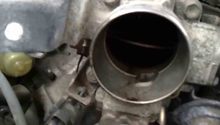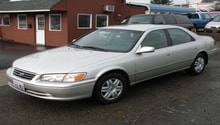Toyota Camry: How to Prevent Carbon Buildup in Engine
If your car is running rough, you may have a carbon deposit buildup problem in your engine.
This article applies to the Toyota Camry 4th, 5th, and 6th generation (1997-Present).
One of the most complained about issues with a Camry, or any other vehicle for that matter, is in regards to a loss of performance and generally a rough idling scenario. You may have experienced this or even a lag in acceleration when the gas pedal is mashed. Many of these problems are a result of carbon buildup in the engine. This is a relatively simple fix if it is caught and addressed in time. If left too long, the piston rings could become damaged beyond an easy fix and may need to be replaced. Don't ignore such issues and take care of your car right away, which will save you bundles in the long run. Most of these preventative measures and solutions can be done easily in your own garage in your spare time. A professional can cost you hundreds, even for simple or routine cleanings that you could easily do on your own.
The best medicine for these issues is to prevent carbon buildup in the first place. Use only the manufacturer's recommended octane for your vehicle. Keep up with the regular maintenance schedule of oil changes, spark plug changes, PCV and EGR valve replacements. Early detection of problems is going to be the cheapest solution in the long run. If you don't have problems right now, using a bottle of fuel treatment every so often will go a long way in keeping your engine clean and running forever.

Materials Needed
- Gasoline treatment
- Throttle body cleaner
- PCV valve
- EGR valve
- Catalytic converter
- Phillips head screwdriver
- Shop rags
- Old toothbrush (or soft-bristle cleaner)
- Pliers (optional)
These steps start with the easiest and cheapest treatment to the more difficult and costly.
Step 1 – Add gas treatment
By far, the most simple cleanup job is to add a bottle of gas treatment such as STP or Sea Foam to your tank. Follow the directions on the bottle. You may want to go through a couple cycles of this, or at least treat every other fill-up with this stuff. They are designed to help burn off the carbon buildup in your cylinder heads, pistons or injectors. If the problem persists, it may take several of these treatments. If you have been suffering a long time with this issue, there is probably some more damage and a root cause analysis will have to be done to replace some parts. Sometimes, this simple procedure won't solve all of your problems, at least not permanently.

(Related Article: How to Use Sea Foam Motor Treatment - CamryForums.com)
Step 2 – Clean out throttle body
Bad acceleration response is usually a result of carbon buildup in the throttle body. A sticking gas pedal is a very common symptom. Both of these are very common to the Camry, and there is a really easy fix for it.
- Find the throttle body behind the main valve cover on the driver's side.
- You will find a big black hose that connects the throttle body to the air cleaner.
- Disconnect this hose at the throttle body using a Phillips head screwdriver on the hose clamp.
- Place a shop rag under this portion of the throttle body because you will have some carbon sludge pouring out.
- Use a can of throttle body cleaner, carb cleaner, or any other product designed for this work and spray it into the opening when you removed the hose.
- Use an old toothbrush or some other type soft-bristle cleaner to get in there and start scrubbing.
- Have someone step on the gas pedal to open the butterfly, and spray some more of the good stuff in there. Then scrub some more.
- Replace the hose and let the car run for a while. Stomp the gas pedal periodically to work that cleaner through and blow out the sludge.
- Proceed to the next step because more than likely (at this point) you'll want to replace the PCV valve as well.

Step 3 – Replace PCV valve
This simple little part attached to your engine will cost you a few bucks to replace. It is amazing the difference it will make in the car once it's there. This little part is connected with a hose at the top, which is easily removed. You may need pliers to pull the valve, or it may simply come out by hand. Carbon buildup is a big factor with this part. It will easily become clogged and stuck closed. This is often the cause of bad performance, and if left unchecked, it will lead to the clogged throttle body that was cleaned up previously. So you'll want to replace this little guy as soon as possible. Make sure to get the correct type for the Camry because they all look very similar, but internally, are very different.

Step 4 – Replace EGR valve
The Camry uses an EGR valve to route some of the exhaust gases back through the combustion chamber to maintain more complete burning of fuel as well as keeping the emissions in check and keeping them cool. The EGR valve can become clogged with carbon buildup, especially on older cars. This is one of the leading causes of a failed emissions check, while the CAT is one of the most often misdiagnosed parts. Many shops will move quickly to replace the catalytic converter, which is much more expensive and it will only temporarily solve your problem. The EGR valve is a pretty cheap part, usually well under $100 to replace. Swapping it out may be a bit difficult and may require a professional if you are not too mechanically skilled. However, it is a vital component to keep clean and your car will be running well for a long time down the road.

Step 5 – Replace CAT
The catalytic converter is a primary system for passing emissions. Often times, it is misdiagnosed as the problem when carbon buildup has led to a failed emissions test. It is an expensive part that is easy to replace and many shops know this, so they will go that route. You may pass a re-check, but will find yourself failing again on the next check. This is because the root cause could have been the PCV, EGR, or any other system that got clogged with the nasty debris and caused your bad emissions. Swapping out the cat should be your last resort, as its lifespan could have been shortened by having other systems go bad.

Related Discussions
- Bad PCV Causing Leaks? - CamryForums.com
- Emissions in PHX - CamryForums.com
- Changed Battery on Camry Now Car Running Rough - CamryForums.com
- Throttle Sticks at Idle Position - CamryForums.com






